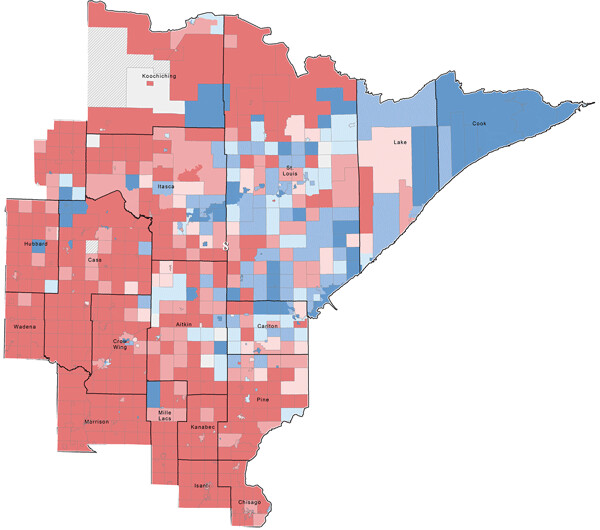News & Articles
Browse all content by date.

Minnesota’s 8th District flipped to red in the Nov. 6 election for U.S. House of Representatives, but St. Louis County remains blue.
The county overwhelmingly supported Democrat Joe Radinovich 57.2 percent over Republican Pete Stauber’s 38.6 percent. Even in the county’s fifth district, where Stauber is commissioner, Radinovich got 1,086 more votes.
Duluth, not surprisingly, voted almost solid blue. The Iron Range shows a patchwork of blue and red, also not surprising since both candidates supported the Polymet mine and the president’s steel tariffs. The northern part of the county, above the Range, voted Republican, but the region is relatively rural with fewer voters.
Carlton, Lake and Cook counties also voted blue by wide margins. In Cook the ratio was nearly 2 to 1 for Radinovich. The four northeastern counties also voted solidly blue in the races for U.S. Senate, governor, attorney general, secretary of state, auditor and state representative.
Stauber won by carrying the western and southern areas of the district including Koochiching, Itasca, Aitkin, Pine and Chisago counties. The regions that voted the most heavily red were on the west and south edges of the district: Wadena, Morrison and Isanti counties. In Morrison, Stauber’s margin was 68 to 28.5 percent over Radinovich. These areas border the conservative 6th District, north and west of the Twin Cities, which elected Michele Bachmann followed by Tom Emmer.
Independence Party candidate Skip Sandman was not, as many feared, the spoiler who enabled Stauber’s victory. Sandman got 4.05 percent of the vote and Stauber won by a margin of 5.54 percent. So even if all of Sandman’s supporters had instead voted Democrat, Stauber still would have won by 1.49 percent.
The 8th has been has been blue in the U.S. House race for most of the past 71 years, but became a swing district in 2010 when Chip Cravaack won by one percent in a surprise victory over longtime Democrat Jim Oberstar. Rick Nolan easily won the seat back in 2012, then narrowly held onto it in the next two races. In 2016 President Trump won the district by 16 percent while Nolan won by 0.56 percent.
The district’s 2018 race was so closely watched that it attracted $9.6 million in outside spending, according to The Center for Responsive Politics (opensecrets.org). But the 8th’s switch to red turned out to be less significant than the 35 seats nationwide flipped by the Democrats, more than enough to take control of the House. Democrats also retook the Minnesota House, which the Republicans had controlled since 2014, by gaining 18 seats.
Gerrymandering has been an issue in many states, including Wisconsin and Michigan, but not so much in Minnesota. District voting lines are reassessed after the census every 10 years. The tea party wave in 2010 put Republicans into control of state legislatures and governorships across the country. The party in charge can redraw voting districts to their advantage. This in turn led to U.S. House elections that favored Republicans. But the 2018 Democrat victories in state legislatures and governorships will enable them to roll back gerrymandering.
In Minnesota, the judiciary has been involved in redistricting since the 1960s. In every cycle, the legislatures and/or the governor could not agree and lawsuits have forced the issue into court. The current lines were decided by a panel appointed by the state Supreme Court and finalized in 2012.
While this system is fairer than gerrymandering, the parties must spend hundreds of thousands of dollars to get the issue through court. Legislators have little incentive to negotiate an agreement if the issue is likely to be decided by the judiciary anyway, and there’s little room for public input.
Some have suggested a system like in Iowa and Arizona, where independent entities determine the lines. But even those can be subject to politics. In 2011, Arizona Gov. Jan Brewer attempted to remove Colleen Mathis, chair of the Arizona Independent Redistricting Commission, under claims of gross misconduct. (“It appears that Mathis’ real misdeed is putting out for public comment a map that the governor and fellow Republicans think is wrong,” wrote the Arizona Daily Star.) The Arizona Supreme Court ordered Mathis to be reinstated.
| Tweet |


